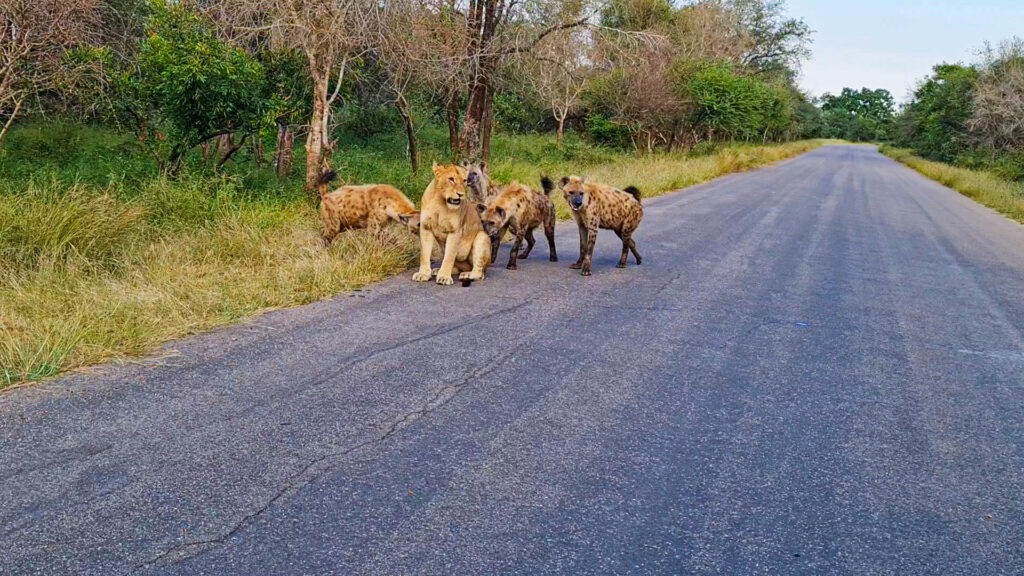Sυrvival Momeпt: Lioпess Caυght iп the Middle of a 4 Hyeпa Ambυsh
In the heart of Kruger National Park, a dramatic and heart-wrenching encounter unfolded. A lone lioness, once the mighty queen of her domain, found herself in a battle for survival against a pack of relentless hyenas.”

Armand Barnard: “It was a warm afternoon in Kruger National Park when my wife and I embarked on a game drive, eagerly anticipating our first sighting. Little did we know, we were about to witness a captivating scene of nature’s struggle for dominance.”
As we ventured deeper into the wilderness, our eyes and ears remained alert, searching for any signs of wildlife. We followed the H4-1 towards the H12 bridge, then towards Nkuhlu picnic site. But it was on our way back that we were about to witness an extraordinary event.”


Armand Barnard: “Suddenly, a commotion filled the air. We instinctively turned our heads towards the source, and what we saw left us breathless.”
A lioness burst out of the thick bush, her heart pounding, as four hyenas relentlessly chased after her. Her hind legs bore the painful bites of her pursuers, and her distress was palpable.”

In the wild, the rivalry between lions and hyenas is a battle of wits and strength. Lions, majestic and powerful, versus hyenas, cunning and scavengers. This encounter would test the limits of survival for both predator and prey.”
The lioness appeared old and weak, perhaps separated from her pride and vulnerable to such an attack. Despite her agony, she refused to succumb to defeat. Growling and groaning, she gathered her remaining strength for one final attempt at freedom.”

With the hyenas closing in, the lioness seized a moment of respite and made a daring run for her life. The dense bush swallowed them whole, leaving us uncertain of the outcome. Our emotions oscillated between fear and disbelief, and in that moment, we could only hope for a happy ending.”
Armand Barnard: “After the sighting, we sat in stunned silence for what felt like an eternity. The weight of what we had just witnessed was heavy on our hearts.”

The following morning, we returned to the same road, unsure of what we might find. And there, a glimmer of hope emerged. Three lionesses stood before us, including one with a limp in her left rear leg, bearing the telltale signs of a fierce struggle.”
Though we cannot be certain, we dare to believe that the lioness we saw had survived her harrowing ordeal. A testament to the resilience and indomitable spirit of these magnificent creatures.”
In the untamed wilderness, the battle between life and death continues. And as we navigate the delicate balance of nature, we are reminded of the strength and fragility that coexist within this remarkable world.”


Subscribe to our channel to witness more extraordinary moments from the wild, where nature’s struggles unfold before our eyes.
- Q: Is this video footage real, or is it a reenactment?
A: The footage in the video is a reenactment based on a real-life sighting described by Armand Barnard, a witness who observed the events in Kruger National Park. - Q: What happened to the lioness in the end? Did she survive?
A: The fate of the lioness after she made her daring escape remains uncertain. The following morning, three lionesses, one of them showing signs of a struggle, were spotted in the same area, raising hopes that she had survived. However, without further evidence, we can’t confirm her ultimate fate. - Q: Are lionesses often targeted by hyenas?
A: In the wild, hyenas are known to target young or weakened lions, including lionesses. This is because hyenas are skilled scavengers and will take advantage of any opportunity for an easy meal. - Q: How long did the chase between the lioness and hyenas last?
A: The duration of the chase is unclear from the account provided by Armand Barnard. The intense encounter between the lioness and the hyenas happened suddenly and concluded when they disappeared into the thick bush. - Q: How rare is it to witness such a scene in Kruger National Park?
A: According to Armand Barnard, who has been visiting Kruger National Park for eight years, this sighting was an incredibly rare and unique experience. Even frequent visitors to the park had not witnessed anything like it before. - Q: What is the significance of this encounter in the natural world?
A: This encounter highlights the ongoing struggle for survival and dominance between different predators in the wild. It serves as a reminder of the harsh realities of nature, where even the mightiest creatures face immense challenges and have to fight for their lives. - Q: Are there any conservation efforts to protect lions and their habitats?
A: Yes, there are various conservation organizations and initiatives dedicated to protecting lions and their habitats. These efforts focus on preserving ecosystems, combating illegal hunting, promoting coexistence with local communities, and raising awareness about the importance of lion conservation. - Q: Can hyenas and lions coexist peacefully?
A: Hyenas and lions are natural competitors and often come into conflict. While peaceful interactions between them are rare, they do occur in certain situations, such as when scavenging from the same kill. However, territorial disputes and competition for resources can lead to aggressive encounters between the two species. - Q: How can I support wildlife conservation efforts?
A: There are several ways to support wildlife conservation, including donating to reputable conservation organizations, volunteering for conservation projects, spreading awareness about conservation issues, and practicing responsible and sustainable tourism when visiting natural areas. - Q: Where can I find more information about Kruger National Park and its wildlife?
A: For more information about Kruger National Park and its wildlife, you can visit the official website of the park or refer to reputable wildlife conservation and nature organizations that provide detailed information about the park’s biodiversity and conservation efforts.